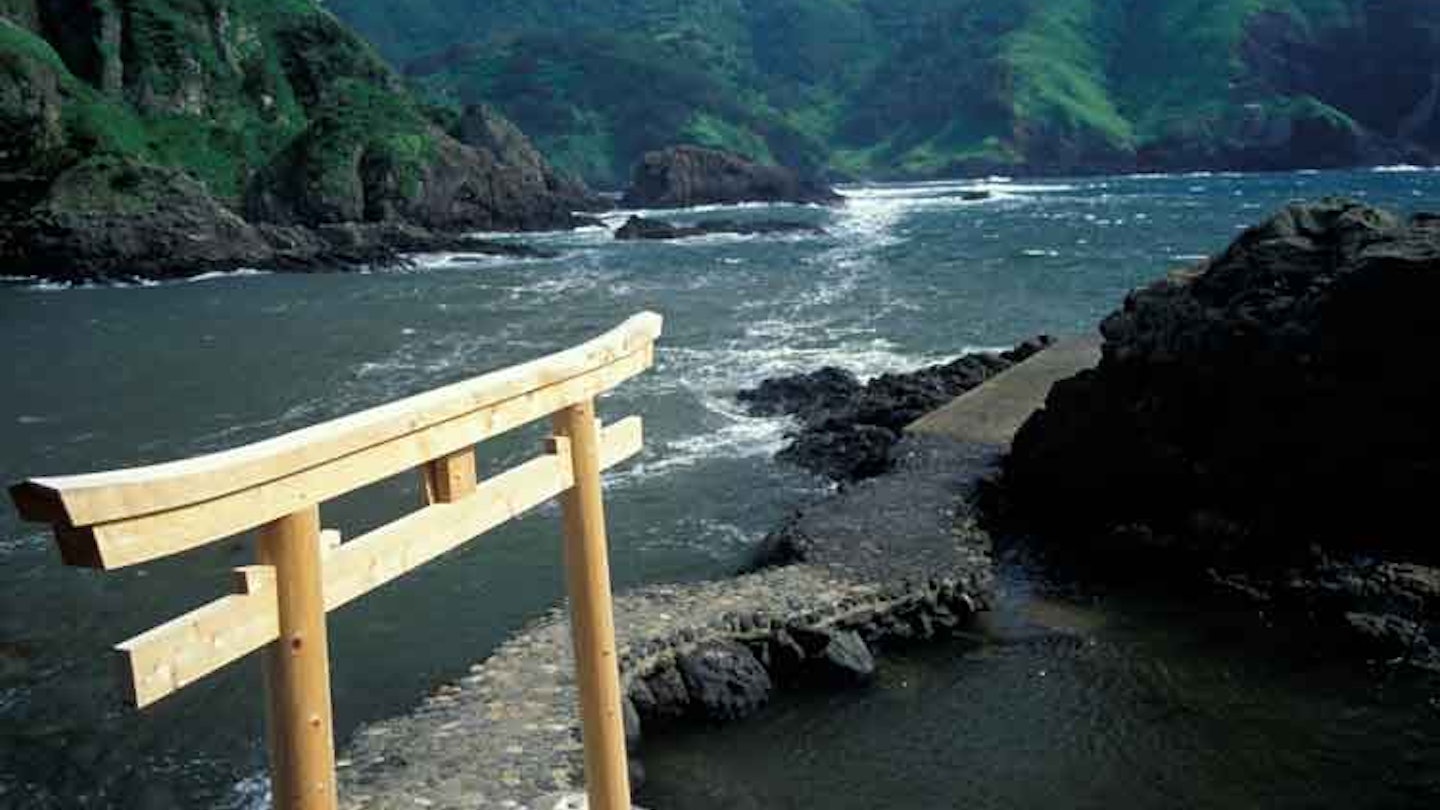

Japan seduces and dazzles travellers with its buzzed-up, sprawling, ultra-convenient big cities. But if you’re weary of crowds and vending-machine-packed streets, get yourself to Matsue in Western Honshū and hop a ferry to the slow life on the remote and fascinating Oki Islands.
Newly added to the Unesco Global Geoparks Network, the islands offer rugged coastline walks, ancient trees, beaches and water sports, Shintō shrines, centuries-old cultural practices and legends of penitent squid. Here is just a taste of what to expect on the four inhabited islands of the Oki archipelago.

Wooden gate overlooking the ocean on the Oki Islands, Japan. Image by Jim Holmes / Axiom Photographic Agency / Getty Images.
Dōgo
The biggest of the four islands, Dōgo is known for its fabulously old and wizened cedar trees, cared for by the locals with a charming reverence. Not far from the main port town of Saigō is 2000-year-old over-achiever Yao-sugi tree, with gnarled branches propped up by posts outside Tamawakasu-no-mikoto Shrine. Another giant, the 800-year-old Chichi-sugi tree, is believed to have a resident deity.
You can see more youthful cedars (at just a few hundred years old) in the Shizenkaiko-no-mori forest. Here you can explore the reptile-shaped Tokage-iwa (Lizard Rock), named for its resemblance to a large lizard climbing up the side of a cliff.
Dōgo’s coastline offers other walks for nature enthusiasts. Experience the varied plant life on a walking track in the south, or wander along the Shirashima coast in the north for deep blue sea vistas and pine trees jutting off the cliff tops. Water lovers can get off the land with sea kayaking, diving, boat tours, or just a frolic on one of the beaches in the summer months.
The island is also home to bull sumō. No, not a bizarre Japanese gameshow showdown between bovine and partially clothed man. Rather, this is bull vs bull. These centuries-old tournaments are held near Shintō shrines in the mountains and involve two bulls being brought together in a ring. Here they butt heads and push at each other until one bull walks away and thus a winner is declared. Handlers stick close by to encourage their bulls, and to help keep them apart and free of injury when the bout is over. Check with the tourist office if you're interested in seeing a tournament.

Yurahime Shrine on Nishino-shima. Image by Laura Crawford / Lonely Planet.
Nishino-shima
The breathtaking and battered Kuniga coast of Nishino-shima is one of the top sights on the Oki Islands. Hike along the scraggy green hills from the sharply falling 257m Matengai Cliff, and you couldn’t feel further away from the urban din of Tokyo and Osaka. Far below, sightseeing boats cruise around the inlets and rock formations to give visitors a different, neck-straining perspective.
Nishino-shima is also home to pretty Yurahime Shrine, which is associated with a curious squid legend. The story goes that, every year, squid crowd into a nearby bay as a way to ask forgiveness of a deity for the offence of having nipped at her fingers. Doubters can check out photos of remorseful squid at the shrine.
Yurahime Shrine, like other shrines on the Oki Islands, has an outdoor covered sumō ring. Oki sumō maintains a strong connection to its spiritual, ceremonial roots. One rather gentlemanly, peace-keeping tradition is for wrestlers to face each other twice – the winner of the first bout is expected to allow their opponent to win the second. You’ll need luck or excellent timing to catch the wrestlers in action, though, as tournaments are only scheduled to commemorate major events, which may be many years apart.
Chiburi-jima
The smallest of the four islands, Chiburi-jima, has the pleasing and appropriate local slogan, nonbiri Chiburi, which translates as ‘carefree Chiburi’. Your first stop here should be the roadside Kawai-no-Jizō spring to fill your water bottle under the quiet gaze of Jizō bodhisattva statues. The springs are considered one of the ‘Top 100 Exquisite and Well-Conserved Waters of Shimane’ - and who can argue with that?
Refreshed, take your carefree self on the worthwhile walk up to Sekiheki (Red Cliff). Evidence of the island’s magma-splattered past, this cliff has a range of rusty hues and changes colour depending on the light. Walking to or from the cliff viewpoint, there’s also a chance of spotting a tanuki, a Japanese raccoon dog.
From Chiburi-jima’s highest point, Mt Akahage, there are wonderful views of the sea and neighbouring islands Nakano-shima and Nishino-shima, forming part of the rough, broken circle of the Dōzen caldera. Across the hillsides nearby are an interesting manmade highlight, the Aigaki stone walls. These are all that remains of a sustainable crop-rotation practice that began on these islands in the Middle Ages.

Kawai-no-Jizō spring on Chiburi-jima. Image by Laura Crawford / Lonely Planet.
Nakano-shima
The Oki Islands have hosted a number of high-profile ostracised officials over the centuries. Nakano-shima, also known as Ama, is famed for being home to 12th-century Emperor Go-Toba, who was exiled following a failed rebellion attempt to regain his lost supremacy. Some 700 years after his death here, Nakano-shima’s Oki Shrine was constructed in commemoration and is now one of the highlights of the island.
Nakano-shima also has more of the ‘exquisite’ Oki fresh water, available at natural springs across the island, and there’s ever more impressive coastline. Along the Akiya coast the red volcanic rock formations are lapped by enticing blue-green waters.
Make it happen
For information in English on access, booking accommodation and eco-tours, contact the Nishino-shima Tourism Office (www.nkk-oki.com). The Oki Islands Geopark (www.oki-geopark.jp/english-top.htm) is an excellent source of info on the natural history and features of the islands.

From island hideaways to neon nightlife, discover the Japan of your wildest dreams with a little help from Lonely Planet's Japan travel guide. And sleep soundly in boutique hostels, traditional ryokan or luxury resorts with some of the expert picks listed in Lonely Planet's author-reviewed hostels and hotels in Japan.















